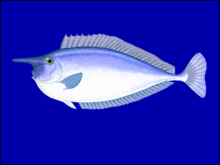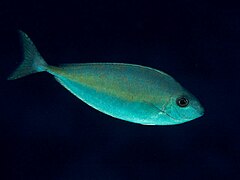Naso (fish)
| Naso | |
|---|---|

| |
Short-nosed unicornfish , N. brevirostris
| |
| Scientific classification | |
| Domain: | Eukaryota |
| Kingdom: | Animalia |
| Phylum: | Chordata |
| Class: | Actinopterygii |
| Order: | Acanthuriformes |
| Family: | Acanthuridae |
| Subfamily: | Nasinae Fowler & Bean, 1929 |
| Genus: | Naso Lacépède , 1801
|
| Type species | |
Naso fronticornis Lacepède, 1801
| |
| Species | |
|
See text | |
| Synonyms[2] | |
| |
Naso is a
This genus is distributed across the Indo-Pacific from Africa to Hawaii.[7]
Taxonomy
Naso was first proposed as a genus in 1801 by Bernard Germain de Lacépède when he described Naso fronticornis as a new species from Jeddah and Mauritius.[2] Lacépède's name was an unnecessary replacement of Chaetodon unicornis described by Peter Forsskål in 1775 from Jeddah.[8] In 1917 David Starr Jordan designated Naso fronticornis as the type species of the genus Naso.[2] Naso is the only genus in the monogeneric subfamily Nasinae, proposed by Henry Weed Fowler and Barton Appler Bean in 1929[9] within the family Acanthuridae.[10]
Species
Naso is divided into 2 subgenera[11] and 20 species are classified within it:[12]
- Subgenus Naso Lacepède, 1801
- , 1825) (Whitemargin unicornfish)
- Naso brachycentron (Valenciennes, 1835) (Humpback unicornfish)
- Naso brevirostris (G. Cuvier, 1829) (Spotted unicornfish)
- Naso caesius J. E. Randall & Bell, 1992 (Gray unicornfish)
- Naso elegans (Rüppell, 1829) (Elegant unicornfish)
- Naso fageni Morrow, 1954 (Horseface unicornfish)
- Naso hexacanthus (Bleeker, 1855) (Sleek unicornfish)
- Naso lituratus (J. R. Forster, 1801) (Orangespine unicornfish)
- Naso lopezi Herre, 1927 (Elongated unicornfish)
- Naso maculatus J. E. Randall & Struhsaker, 1981 (Spotted unicornfish)
- Naso mcdadei J. W. Johnson, 2002 (Squarenose unicornfish)
- Naso reticulatusJ. E. Randall, 2001 (Reticulated unicornfish)
- Naso tergus H. C. Ho, K. N. Shen & C. W. Chang, 2011
- Naso tonganus (Valenciennes, 1835) (Bulbnose unicornfish)
- Lacépède, 1801 (Humpnose unicornfish)
- Naso unicornis (Forsskål, 1775) (Bluespine unicornfish)
- Naso vlamingii (Valenciennes, 1835) (Bignose unicornfish)
- Subgenus Axinurus Cuvier 1829
- Naso caeruleacauda J. E. Randall, 1994 (Blue unicorn)
- J. L. B. Smith, 1966) (Slender unicorn)
- Naso thynnoides (G. Cuvier, 1829) (Oneknife unicornfish)
Etymology
Naso means "nose" referring to the fleshy protuberance on the forehead of N. fronticornis.[11]
Characteristics
Naso unicornfishes have a pointed snout and a rhomboidal or oval shaped body, with some species possessing a long protuberance on the forehead, typically present in both males and females. The
Distribution
Naso unicornfishes are found in the Indo-Pacific region from the eastern coast of Africa to the Galápagos Islands.[13]
Biology
Naso unicornfishes differ from other Acanthurids in that they eat zooplankton rather than grazing on algae or detritus and that they tend to live at greater ranges of depth.[13]
-
Whitemargin unicornfish, Naso annulatus
-
Short-nosed unicornfish, Naso brevirostris
-
Sleek unicornfish, Naso hexacanthus
-
Orangespine unicornfish, Naso lituratus
-
Naso reticulatus
-
Bluespine unicornfish, Naso unicornis
-
Bignose unicornfish, Naso vlamingii
References
- ^ Sepkoski, Jack (2002). "A compendium of fossil marine animal genera". Bulletins of American Paleontology. 364: 560. Retrieved 2008-01-08.
- ^ a b c Eschmeyer, William N.; Fricke, Ron & van der Laan, Richard (eds.). "Genera in the family Acanthuridae". Catalog of Fishes. California Academy of Sciences. Retrieved 10 July 2023.
- ^ Dayton, C. (2001). "Genetic evolution among selected members of the genus Naso (Nasinae), "unicornfishes" from Guam". Marine Biology. 139 (4): 771–76.
- ^ Fishing at the tip of the spear in Guam
- ^ "Unicorn Fish the weird but delicious fish". The Arena Media Brands, LLC. Retrieved 10 July 2023.
- ^ "Acanthuridae (Surgeonfishes/Tangs)". Reef App encyclopaedia for marine animals. Kasper Hareskov Tygesen. Retrieved 10 July 2023.
- doi:10.2307/1447705.
- ^ Eschmeyer, William N.; Fricke, Ron & van der Laan, Richard (eds.). "Species in the genus Naso". Catalog of Fishes. California Academy of Sciences. Retrieved 11 July 2023.
- PMID 25543675.
- ISBN 978-1-118-34233-6.
- ^ a b Christopher Scharpf & Kenneth J. Lazara, eds. (12 January 2021). "Order ACANTHURIFORMES (part 2): Families EPHIPPIDAE, LEIOGNATHIDAE, SCATOPHAGIDAE, ANTIGONIIDAE, SIGANIDAE, CAPROIDAE, LUVARIDAE, ZANCLIDAE and ACANTHURIDAE". The ETYFish Project Fish Name Etymology Database. Christopher Scharpf and Kenneth J. Lazara. Retrieved 10 July 2023.
- ^ a b Froese, Rainer and Pauly, Daniel, eds. (2023). Species of Naso in FishBase. February 2023 version.
- ^ ISBN 978-1-990951-32-9.
- doi:10.2307/1446677.













